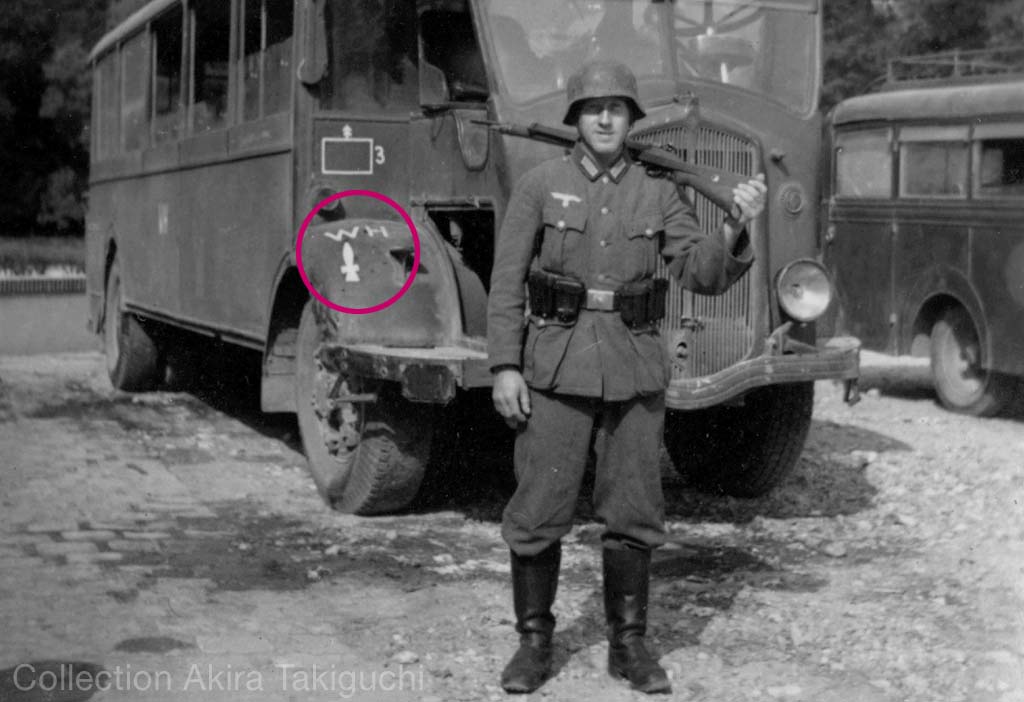Click the image for a larger scan

One of the reasons I am so into German WWII photographs is the abundance of vehicle markings (Taktische Zeichen as well as Truppenkennzeichen). Because many german vehicles were so clearly marked (especially in the early stage of war),it must have been an effective enemy deception measure to change it for special operations. Kursk markings adapted by Heeresgruppe Süd in 1943 is quite well known and thoroughly researched by Dr. Regenberg. Similar deception measure, albeit less known, was taken in 1941 in Armeeoberkommando 18 during the preparation stage of Operation Barbarossa. Richtlinien für die Feindtäuschung ("Correct method for enemy deception" - Weisung OKH/WFSt./Abt.L. - February 1941) ordered to use new geometric Truppenzeichen for all divisions.
290.Infanterie-Division used a white vertical sword† in 1940 (the division was called Schwert-Division because of this symbol).The division received a new geometric marking† according to the order, adapted as of March 8, 1941. This was retained till autumn 1941.
58.Infanterie-Division also adapted a geometric marking† (the original symbol was twin horse heads). The magnificient work Die Truppenkennzeichen der deutschen Wehrmacht by Schmitz/Thies does not mention this one, but shows a similar (but rotated by 90 degree) one. According to the book this "A" sign was adapted after the divisional commander Gen.Maj. Dr. Altrichter. He commanded the division from September 1941 to March 1942. I have (yet) no reason to deny this because the photo album that carries this photograph was presented to Hauptmann Schutz on 17 Nov. 1941, but it is likely that this symbol was also the result of February order (effective later because 58.Inf.-Div. was not under AOK 18 till May).
122.Infanterie-Division, also called Greif-Division proudly adapted a claw of Greif (griffin) as its symbol. Even when the February order was in effect, the division adapted both markings in most cases as seen in this photograph†. Schmitz/Thies volume 4 made a mistake (the document deceived researchers 50 years later!) by updating correct volume 1 description.
12.Infanterie-Division is also misidentified in Schmitz/Thies volume 4.The correct marking is shown here†. The symbol does not feature an arrow. Actually the "arrowed" symbol is for 30.Infanterie-Division and it is clearly shown in a soldier's album from the division. An Opel truck† from the Sanitätsabteilung is running in the mud. You can see the symbol in another picture†, and also seen on a captured T38 tank†. This amphibious tank is now used as ambulance tank. the division was commanded first by General Kurt von Briesen, then General Kurt von Tippelskirch†.
Geometric symbols were also adapted by Armeekorps level as seen here†, this was the X.Armeekorps symbol. The picture is also from the album of San.Abt.30.
Another army level formation in Heeresgruppe Nord, Panzergruppe 4, seems to have adapted a similar measure in the fall of 1941. The two panzer divisions in the Panzergruppe were 1.Panzer-Division and 6.Panzer-Division. 1.Panzer, proudly presented Eichenlaub (oak leaf) as its symbol. This symbol† was usually painted in white (here an Sd.Kfz.251 from 2./1.Schützen-Regiment 1, a rare photo from the first Abteilung in 1940), but as seen in this example†, sometimes the veins are painted in a different color (yellow or more probably, green. To the right is Lt. Darius). The official OKW symbol†, an inverted Y, was used often together with an Eichenlaub. 6.Panzer used a inverted Y with two dots† in 1940.This symbol was usually painted in yellow. A new symbol, XX, replaced it (the symbol was formerly used by 9.Panzer).
In the fall of 1941, both adapted a new symbol. 6.Panzer used an axe† - here you can see vaguely the old XX symbol below the axe (photo is from an album of Panzer-aufklärungsabteilung 57). This symbol has been known for a long time (even Panzer Colors II showed it), but the next symbol must be unknown to most of the readers.Here is the symbol of 1.Panzer† adapted (probably) during the same period (photo shows Panzer III's from 6.Kompanie). Since I got to know that 6.Panzer used a special symbol in 1941, I had always in mind that 1.Panzer must have adapted something similar.It took me more than 20 years to prove my hypothesis!
Both divisions were transferred to Panzergruppe 3 in early October. These Pz III's are about to be transferred on the railway - it suggests that this photo was taken on around September 21 when the movement commenced, and these markings were adapted to disguise the movement of the division for the Heeresgruppe Mitte. Technically at this time the division (or A.K.) was still under Pz.Gr.4.